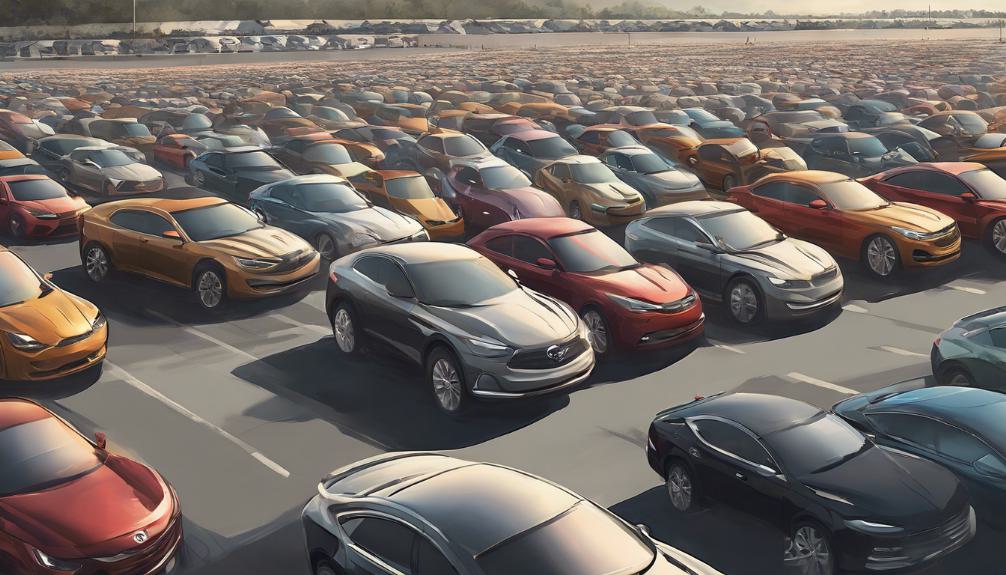When unsold, new cars gather at dealerships, they employ strategies to manage inventory effectively. Offering discounts, incentives, and targeted marketing campaigns help move slow-moving stock. Cars can be repurposed as loaners to attract buyers with lower price points. Dealerships may also trade unsold cars with others to expand market reach. Auctioning to wholesalers helps recover costs and makes room for newer models. These methods aim to optimize sales opportunities and keep inventory levels balanced. Further insights into managing unsold inventory can reveal additional strategies dealerships use to navigate the automotive market effectively.
Key Takeaways
- Unsold cars are discounted, incentivized, and marketed to attract buyers.
- Some unsold cars are repurposed as loaner vehicles to enhance customer experience.
- Dealerships may trade unsold cars with other dealers to optimize inventory.
- Unsold cars can be auctioned off to wholesalers to recover costs and make room for newer models.
- Various strategies like discounts, incentives, and trading are used to manage unsold inventory effectively.
Strategies for Selling Unsold New Cars

To move unsold new cars efficiently, dealerships employ various sales strategies such as offering discounts, rebates, and incentives. In addition to these traditional methods, dealerships run targeted marketing campaigns and online promotions to attract potential buyers. These campaigns aim to increase customer engagement by providing personalized offers tailored to individual preferences. By analyzing customer data and behaviors, dealerships can create specific promotions that resonate with each customer, increasing the likelihood of a successful sale.
Through marketing campaigns, dealerships can reach a wider audience and generate interest in their unsold new cars. Online promotions, such as limited-time offers or exclusive deals, can create a sense of urgency and drive customers to make a purchase decision quickly. By combining these strategies with personalized offers based on customer preferences, dealerships can effectively clear out unsold new cars while also enhancing the overall customer experience. This proactive approach benefits both dealerships and manufacturers by optimizing inventory turnover and maximizing profitability.
Offering Incentives and Discounts
Dealerships strategically offer incentives and discounts to motivate potential buyers to purchase unsold new cars. These marketing promotions aim to attract customers by providing special deals like rebates and discounts. Manufacturers also play a role by offering incentives to help dealers clear out slow-moving inventory.
Seasonal campaigns and referral programs are common tactics used to entice buyers and build customer loyalty. Generous discounts are often applied to slow-selling cars in order to reduce losses and minimize the opportunity costs associated with unsold inventory.
Repurposing Unsold Cars as Loaners

Repurposing unsold new cars as loaner vehicles offers dealers a strategic way to reduce inventory and attract potential buyers. By converting slow-selling vehicles into loaner cars, dealerships can showcase features and benefits to customers, enhancing the customer experience through firsthand interaction. These loaner cars not only help maintain the vehicles in good condition but also allow dealers to offer them at a lower price point due to their used status. This strategy not only manages inventory levels effectively but also creates marketing benefits by increasing the chances of these vehicles being sold.
Using unsold inventory as loaner cars provides an opportunity for potential buyers to test out the vehicles, potentially leading to a sale. Customers can experience the vehicle's performance, comfort, and features firsthand, making a more informed purchasing decision. From a marketing perspective, loaner vehicles act as mobile advertisements, showcasing the brand's offerings and attracting interested customers. Repurposing unsold cars as loaners is a practical approach that benefits both dealerships and customers alike.
Trading Unsold Cars to Other Dealerships
When dealerships trade unsold cars with other dealerships, they expand their market reach and increase the likelihood of selling the vehicles. This practice of exchanging inventory between dealers helps in inventory optimization by ensuring that each dealership has a mix of vehicles that align with customer demand. It also enables market expansion, as dealers can acquire models that might be popular in a different region or with a specific customer base. By balancing their inventory levels through these trades, dealerships can cater to a broader range of potential buyers and improve overall sales performance.
Negotiating the terms of these trades is essential for both parties to benefit. Dealerships can leverage surplus inventory to obtain preferred models in exchange or adjust pricing to match market demand effectively. This strategic approach to trading unsold cars among dealerships serves as a practical way to optimize sales opportunities and minimize losses on slow-moving inventory.
Auctioning Unsold Cars to Wholesalers

If unsold cars at dealerships fail to find buyers through trade, the next option often involves auctioning them off to wholesalers, allowing dealers to recover costs and make room for newer models. Wholesale auctions play an essential role in helping dealerships manage their inventory effectively.
Wholesalers purchase these unsold cars at auctions, aiming to resell them in different markets where there might be higher demand. The profitability of auctioning unsold cars to wholesalers depends on various factors such as market demand and resale value. However, auction prices for unsold cars are typically lower than retail prices, impacting dealership profits.
Despite this, auctioning unsold inventory remains a viable solution for dealers to free up space for newer, more desirable models. By participating in wholesale auctions, dealers can mitigate losses on unsold inventory and optimize their overall vehicle turnover process.
Importance of Inventory Management
Efficiently managing inventory is essential for dealerships to optimize profits and minimize costs linked to unsold new cars. Inventory optimization involves prioritizing the sale of popular models to maintain cash flow and create room for incoming inventory.
By focusing on selling well-received vehicles, dealers can reduce the chances of ending up with unsold stock. Stock rotation plays an important role in this process, as it ensures that newer and more profitable models are prominently displayed to attract potential buyers.
Strategic placement of unsold new cars on the lot and in marketing efforts can greatly increase visibility and enhance sales opportunities. Marketing tactics tailored to showcase these vehicles effectively can help dealerships move stagnant inventory and improve overall sales performance.
As an Amazon Associate we earn from qualifying purchases.










